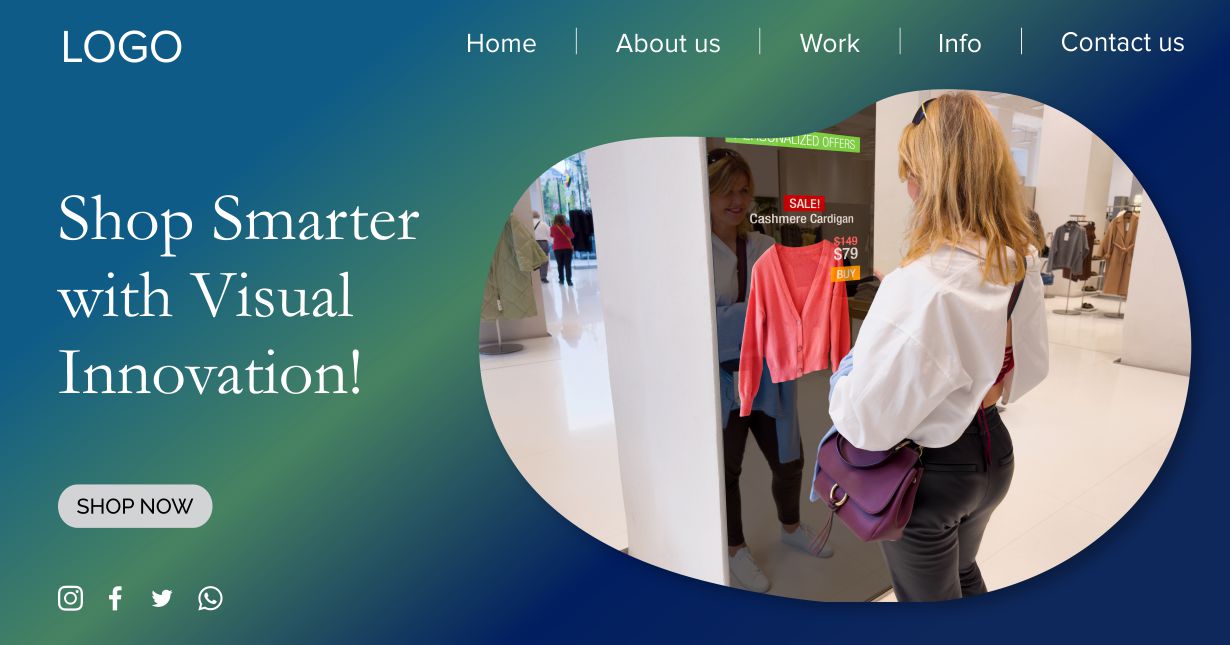We as consumers always want the best, whether it’s a product or service. Similarly, while searching for products online we want the best experience, and to deliver that, Visual commerce is becoming a beacon for brands to deliver the best experience.
In this advancing market, eCommerce brands are turning to immersive, image-driven strategies to capture attention and drive conversions. With virtual commerce now being a vital part of shopping experiences, many companies are leveraging visual assets to elevate the buyer’s journey and stand out from the rest of the market.
Here in this piece, we will explore the rise of visual commerce, its core components, and how eCommerce brands care to stay ahead of retail shopping trends in 2025.

What is Visual Commerce?
Visual Commerce refers to the use of visual content such as images, videos, augmented reality (AR), and virtual experiences. This enhances online shopping. Rather than relying solely on product descriptions or static product photos, visual commerce creates an engaging, interactive experience that mirrors in-store browsing.
It taps into the human brain’s preferences for visual stimuli, offering a richer, more intuitive way to shop. As part of the latest trends in retail, visual commerce helps build trust, boost product understanding, and reduce friction in decision-making, leading to higher sales and strong brand loyalty.
Where Does Visual Commerce Come From?
The start of visual commerce can be traced back to the growing demand for digital transformation in retail. As traditional eCommerce matured, so did the need for better product visualization, especially in industries where physical touchpoints play a crucial role.
Want to know everything about visual commerce? Read the linked blog.
With the rise of mobile shopping, high-speed internet, and AI platforms, consumers began demanding real-life-like experiences online. The pandemic accelerated this shift, now eCommerce brands are forced to innovate, and visual content has become a powerful tool to simulate in-store interactions.
Virtual commerce is a convergence of technology, creativity, and consumer-centric design that reshapes the future of retail shopping trends.
Types of Visual Commerce
You might think that visual commerce is just one or two elements on a website, but it’s much broader than that. On a bigger scale, they can be categorized into static and dynamic formats. Each of them plays a distinct role in building smooth, interactive, and conversion-oriented shopping experiences.
Static Visual Commerce
This includes non-moving, yet interactive visuals that help buyers engage with the product in creative ways. These can be classified as:
Know why virtual showrooms are best for furniture eCommerce website.

Hotspots
Hotspots are clickable areas embedded within an image through which users can get more information about a product such as product price, details, or purchase link with just a hover or tap.
This allows eCommerce brands to use hotspots to improve product discovery without overwhelming users with unnecessary information.
Lookbook/Shop the Look
Lookbooks present users with curated outfits on styled collections. With the ‘Shop the Look’ feature, users can click on individual pieces and purchase the entire look directly. This strategy is heavily employed in fashion and apparel, turning inspiration into immediate conversion.


Feed Aggregators
These are the most interactive as feed aggregators compile customer-generated images from social media to present the website visitors with real-world product usage. This builds trust and social proof, essential to modern virtual commerce strategies.
3D Images
3D visuals offer a 360-degree view of the product. Customers can rotate, zoom, and inspect items as if they were holding them. This is especially useful for eCommerce brands that work in industries like home decor, electronics, and furniture.
Study how AI-powered virtual try on is disrupting retail market.

Dynamic Visual Commerce
Moving on to dynamic visual commerce, they go beyond static and use real-time interaction through motion-based or immersive experiences.

Shoppable Videos
These are videos where viewers can click on products to buy directly while watching. This combines storytelling and sales in a way that boosts engagement, a crucial element of the latest trends in retail.
Virtual Try On
Using camera-based tech and AI, a virtual try on allows users to see how products such as clothing, eyewear, cosmetics, shoes, jewelry, etc., will look at them. This is a growing subset of virtual commerce, helping brands personalize experiences.


Augmented Reality (AR)
AR enables shoppers to place virtual products in their physical space like visualizing how a sofa fits in a living room. AR is revolutionizing retail shopping trends to make online purchases more confident and informed.
Immersive Experiences
From virtual showrooms to gamified product discovery, immersive experiences blend entertainment and eCommerce. These experiences are reshaping how consumers explore, elevate, and interact with products online.

How Leading Brands Are Leveraging Visual Commerce to Dominate the Market
Top eCommerce brands across industries embrace visual commerce to stand out, boost engagement, and drive sales. Let’s explore how different sectors are applying these strategies in 2025.

Fashion and Apparel
Visual commerce has been impressive in the fashion industry. Brands like ASOS and Zara have implemented virtual try ons that let users see how clothes look in real-time. Shoppable lookbooks, influencer-led videos, and AR-powered sizing guides are redefining how consumers shop for fashion online.
These tools help reduce returns, improve satisfaction, and drive loyalty. Adopting these latest trends in retail, fashion labels are transforming their websites and apps into visual-first experiences, where storytelling meets shoppability.
Beauty and Cosmetics
The beauty industry has quickly adopted virtual commerce technologies like AI-driven skin analysis and virtual makeup try-ons. Brands like L’Oréal and Sephora use AR to let customers try on lipstick, foundation, and more through their phones.
Learn the top application of online showroom in the digital world.
This solves one of online beauty’s biggest challenges, which is seeing how products will actually look on different skin tones. Shoppable video tutorials, interactive guides, and customer-generated content also form key pillars of visual commerce in beauty.


Furniture and Home Decor
For furniture retailers, visuals are vital. IKEA, for example, uses AR to let shoppers place sofas or tables in their rooms using a smartphone camera. This builds confidence in product size, color, and style, things that are hard to judge from static images alone.
A number of home decor eCommerce brands also offer 3D product visualizations, room simulators, and hotspots that detail fabric, dimensions, and use cases. These innovations align with emerging retail shopping trends that merge online and offline experiences.
Electronics and Gadgets
Tech-savvy consumers expect detailed product views and interactive experiences when shopping for electronics. Apple and Samsung lead the way by offering 360-degree product views, shoppable how-to videos, and virtual demo stations.
For example, potential buyers can explore every nook and canny of the device and watch tutorials before buying the product. These visual-first strategies help reduce decision fatigue and increase conversion rates.

The Future of Visual Commerce
As we move ahead, visual commerce will only grow more intelligent, personalized, and immersive. Innovations such as spatial computing, AI-drive designs, and mixed reality will further blur the line between physical and digital retail.
Know the cost of building a virtual store tour.
Some of the key future-forward developments are:
AI-Powered Personalization:Smart algorithms will show visuals customized to each shopper’s preferences.
3D Product Configurator:This allows customers to build and visualize products before purchasing.
Web3 and Virtual Worlds:Brands will use metaverse platforms to build virtual stores and branded experiences.
Voice + Visual Integration:Voice assistants will combine visuals for multi-sensory shopping journeys.
eCommerce brands can tap into the future of virtual commerce, meeting customers where they are by embracing these technologies. They can use their devices in their spaces and in their moments of inspiration.
Conclusion
In 2025, visual commerce is not just a trend; it’s a necessity. With customer expectations at an all-time high and digital experiences defining brand loyalty, companies must think visually to win.
From virtual try ons and AR to shoppable videos and interactive images, eCommerce brands across sectors are leveraging visual commerce to drive growth, engagement, and conversions. As the line between real and virtual continues to blur, the brands that dominate will be those who not only follow the latest trends in retail but innovate ahead of them.
To stay competitive in this new age of virtual commerce, now is the time to invest in immersive, interactive, and intelligent visual solutions that meet the demands of modern consumers.
If you want to learn more about visual commerce or want to implement it on your website, then reach out to our team on sales@iphygital.ai.
